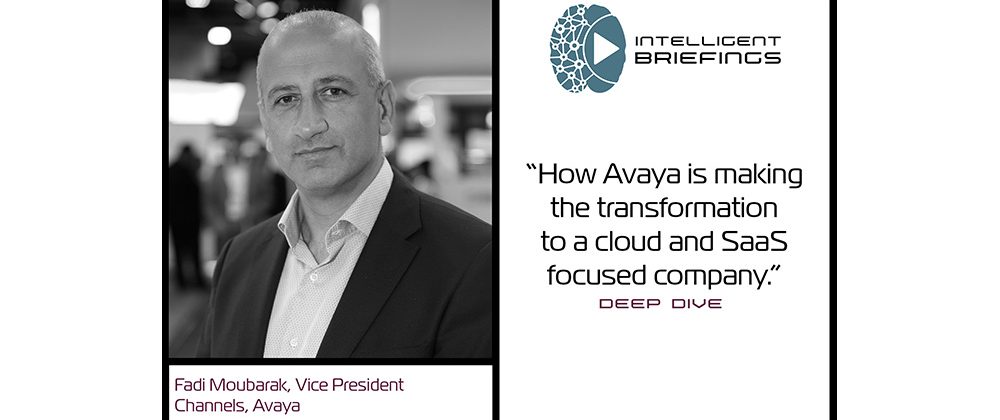The new normal requires organisations to use tools that increase agility and enable Business Continuity. An evolution to cloud technology is an integral part of this approach. Fadi Moubarak, Vice President – Channels, Avaya, tells Intelligent Tech Channels‘ Rebecca Miles how Avaya is making the transformation to a cloud and SaaS focused company and talks us through what this means for the company’s channel strategy and channel partners.
Avaya has been making a transformation to a cloud and SaaS focused company. Why this is important for Avaya and its customers, particularly in the new normal?
When looking at the move to the cloud, we start with the customer – that’s always the start and end point of any decision or trend. If you step back and look at the economic or micro or macro environment, usually around the world, you see customers have had to deal with a lot of changes and a very dynamic environment over the past few years, even before COVID-19.
There are always sudden changes, whether economic pressures or opportunities in certain sectors, so we see customers having to change the way they work almost every six months for one reason or another. This is where the power of the cloud or OpEx general model comes in because it gives the customer a certain level of agility.
Firstly, if they adopt a certain solution it doesn’t take a long time to implement – they can turn it on and consume. And secondly, sometimes they’ll need to consume a certain technology for a period of time and then shift the use for something else. And again, in cloud that is possible.
With the CapEx environment investment, by the time the solution is up and running, the need is gone.
We realised we needed to offer agility to our customers. At the same time, we also realised that the needs of our customers are not always standard.
Even in the same industry, in the same country, you see banks or financial institutions, or governments or service providers approach their customer experience and customer centre differently.
There was a need to combine the best of both worlds. That’s why we implemented a strategy to move to cloud – not in an abrupt manner but rather in an evolution.
This is in the sense that our products used to be available in CapEx, then we made them available in subscription so they can still be used on-premises but paid for on subscription.
Then we started to introduce a private club which still creates a unique environment for every customer but is totally hosted, managed and operated by Avaya, so the customer gets the benefit of the on-premises solution but in a cloud flavour.
And last but not least, we have the public cloud services, things like we are launching now in the UK, where the customers have their requirements met by a public cloud. They can just consume as fast as possible; they don’t need to have their own customisation. They can have integration points that are built into the solution – but the customisation needs are low, because they are not always available in a public cloud offer.
With all these flavours, the customer now has the right option that fits their current situation or their future plans.
From here, it is important to have a smooth cloud evolution. It wasn’t about just launching another cloud service but offering a path to the customer to become more agile in consuming technology and more agile in adapting to the environmental changes.
The repercussions of the current situation will be felt for a long time and I think the new normal will see customers, agents, contact centres etc all working from home. This is going to become normal and the exception will be face-to-face. To what extent, we will see, but at least our solutions enable the customer to deal with either end of the changes and anything in between.
Can you talk about some of the investments and solution announcements Avaya has made in recent months?
Investments, including R&D investments, are ongoing things for a technology vendor across our whole product range, from releasing our products in subscription to bringing up new releases and new features.
Even on the devices we have released, some are open devices where they are available to work with Avaya and non-Avaya applications, especially in the collaboration space. For example, the CU360, which is a room that will allow any customer to connect to any collaboration out there in the market, Avaya or not.
Of course, on Oceana, which is our flagship on-premises contact centre product, we are having new releases practically every three months, introducing new features and evolving towards introducing more and more integration capabilities.
Because we realised that we – along with our ecosystem of partners – need to provide end-to-end applications. We are not trying to be everything for everybody, but we are trying to allow anybody to integrate us with any other business application they have.
That’s why we have also invested in expanding our ecosystem of partners and building more integration capabilities, APIs, into our existing products because we realised that the power of any solution is not only around the functionality if offers, but in the integration capabilities it offers.
Every customer has their own key business application that they would like to integrate with contact centre or unified communication applications and serve their customers in a certain way or operate and collaborate with their employees in certain ways. This is where our investments are going.
Given the current challenges around travel, how is Avaya continuing its channel enablement and training efforts?
Avaya Spaces is our platform and we have seen our partners increasingly adopting it, even to collaborate internally and not just with Avaya. We are using the time now, during lockdown, to maximise the capabilities of our online courses that can be delivered. And then we’ll leave the hands-on classroom-based enablement to [hopefully] this summer to catch up when needed.
Even our enablement has been transformed to be able to be delivered remotely, even if it is technical and hands-on, it can be done through remote learning.
Marketing funds that are usually used for events and face-to-face activities have shifted to deliver enablement. We have weekly webinars on all our new functions – all the new capabilities, new alliances, new business models, to make sure our partners are all up to speed, so when they go back into the field they are ready and have benefited from this time away as much as possible.
What does Avaya’s cloud transition mean for your channel strategy and channel partners?
It definitely means a transition in the value proposition of our partners. Traditionally, in the CapEx world, the value proposition of a partner is to have the capabilities to sell, install and support a certain solution.
In the cloud, it is pre-installed and pre-managed, so the value proposition of the partner is really on the customer success front.
It’s making sure that the customer chooses the right cloud application and functionality integration and uses it properly to achieve the objective they want.
It is an important evolution for our partner value proposition, where they need to shift their skills to focus on things like integration, customisation and linking the business process to the technology, rather than the previous focus on the technology and how to install and support it.
That is becoming less and less important because, in the cloud, the technology is installed once and used many times. But you definitely need to work with the customer to use it properly, integrate it within their business processes or customise it to integrate it with their business applications. And this is what our partner value proposition is evolving towards.
Tell us about #AvayaCares and how Avaya’s VADs stepped up during COVID-19 to help businesses benefit from the Avaya Spaces and Avaya CC offers?
That was another aspect of our historical focus on Business Continuity. Being a UC and contact centre application vendor, these are both very mission-critical applications.
Business Continuity was always part of our plan and in our discussions with partners. When COVID hit, we just activated those protocols. We worked with all partners and customers to make sure they could continue operating, whether their employees were connecting remotely or not, so that’s why we enabled offers to get licences for free, to ensure they could continue to operate as quickly as possible.
Whether they are contact centre agents – the load on the contact centre was tremendous for most organisations – whether a healthcare or service provider or travel such as an airline with people stranded, we all suffered from not being able to reach the agents easily in contact centres.
Our mission was to make sure, whatever it takes, that Business Continuity plans were executed for our customers – and we made it available for them. We had great success in the sense that thousands of agents, in a period of two weeks, were able to work wherever they were.
We are now continuing to work with all those customers with the support of our partners to see what the final long term plans are in all this – how many will really come back and how many will continue working in that manner.
And what other applications can be introduced as part of the contact centre to help cater and handle the extra workload now coming their way, which is going to continue for a period of time because of the repercussions of COVID-19.

